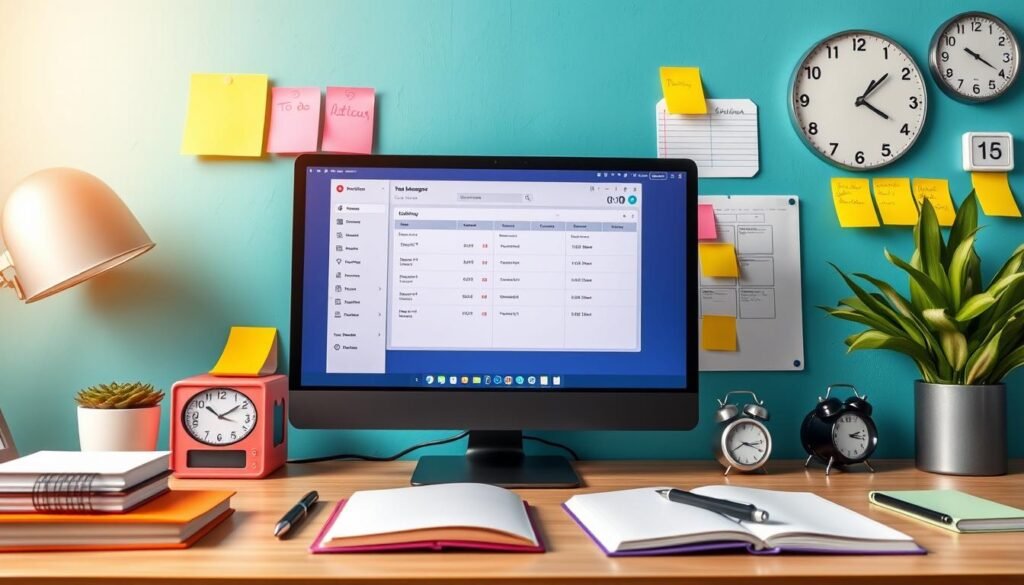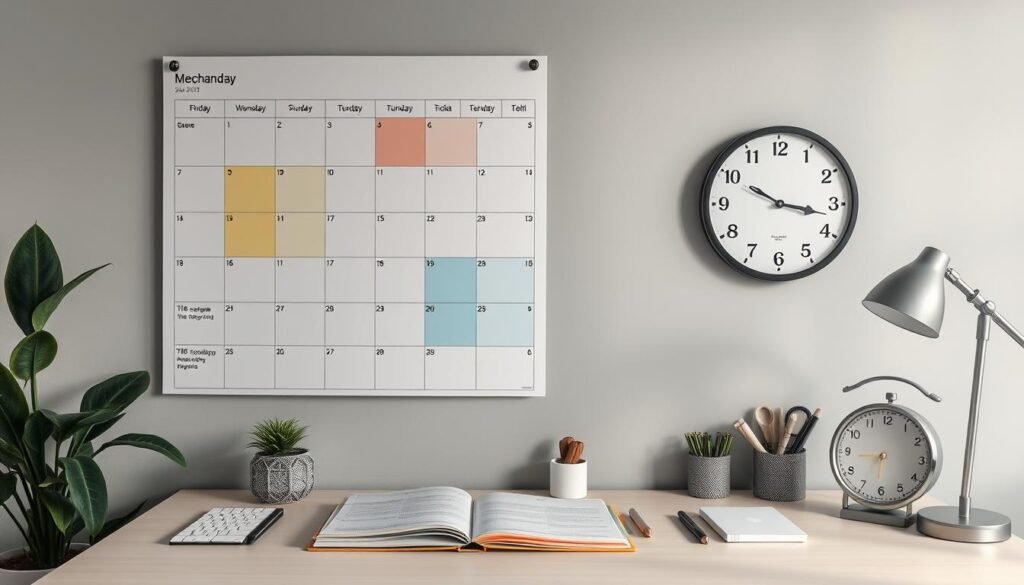New Year, New Workflow: Tips for Organizing To-Do List
Some links on this page are affiliate links. This means we may earn a commission at no additional cost to you if you click through and make a purchase. Thank you for your support!
New Year, New Workflow, starting fresh this new year is the perfect chance to change how we manage tasks and organizing Your To-Do List. Those old to-do lists on scraps of paper often get lost or forgotten. This leaves us feeling overwhelmed and stuck.
But there’s a better way. It’s time to use digital task management to make our workflow more efficient. By organizing our to-do lists, we can take back control of our time. We can focus on what really matters. Are you ready to say goodbye to chaos and hello to a more productive year? Let’s get started!
Key Takeaways
- Switching to digital task management helps with sorting, prioritizing, and keeping lists safe.
- Today’s task management apps offer features like creating multiple lists, setting deadlines, and sending reminders. They also help us work together.
- Good to-do lists are clear, focused, and have deadlines.
- Breaking big tasks into smaller ones and using action verbs makes them easier to understand and do.
- Putting your most important tasks first, like the “eat that frog” method, can really help you get more done.
Understanding the Power of Digital Task Management
In today’s fast world, managing our tasks can be tough. Moving from paper to digital task management has changed how we organize and work. Task list apps help us do more with less stress.
Benefits of Moving from Paper to Digital
Switching to digital task management has many benefits. Digital tools make it easy to sort and prioritize tasks. This means we focus on what’s most important.
With digital tools, we don’t have to worry about losing our lists. Our important information is always with us. We can also add details like due dates and notes, making us more productive.
Key Features of Modern Task Management Apps
Today’s task list apps do more than just list tasks. They offer features for different needs. We can create lists for various projects and track deadlines easily.
Many apps also let us work with others. This makes it easier to reach our goals with team members or family.
Integration Capabilities with Other Tools
Digital task management works best when it connects with other tools. For example, Google Calendar and productivity hacks. This integration helps us manage our tasks and schedules better.
Using digital task management helps us control our tasks and reduce stress. It helps us reach our goals faster. By using modern task list apps, we can be more productive and efficient.
Why Traditional To-Do Lists Often Fail
To-do lists are a common tool for managing our tasks. But, they often don’t meet our expectations. Let’s look at why they might not help us manage our time and stay productive.
One big problem is adding too many tasks. Our brains try to remember every single thing. This makes our lists too long and can make us feel unmotivated. Prioritization becomes hard when everything seems equally important.
Another issue is how we estimate the time needed for tasks. Only 17% of people get it right. This means we often set unrealistic goals and feel like we’re always behind.
- 76% of Americans use a to-do list, but 41% of to-do list tasks never get completed.
- People, on average, have about 15 ongoing goals and projects at a given time.
- Research indicates that 76% of U.S. citizens and 78% of Canadians have at least one to-do list.
Traditional to-do lists can also distract us from important tasks. We might choose to do easy tasks instead of the hard ones. This can make us feel productive, even if we’re not really moving forward with our smart goals and prioritization strategies.
“The to-do list is a powerful tool, but it’s also a passive one. It doesn’t help you prioritize, it doesn’t help you schedule, and it doesn’t help you manage your time.” – David Allen, author of “Getting Things Done”
To improve, we need to try new ways of managing tasks. By using better time management and productivity tips, we can create a system that helps us focus and achieve our goals.

Essential Components of an Effective Task Management System
Boosting productivity and managing our to-do lists is key. A strong task management system is vital. It helps us capture tasks, prioritize them, and set realistic deadlines. Each step is crucial for achieving our goals efficiently.
Capturing and Processing Tasks
The first step is capturing all tasks that need to be done. The Getting Things Done (GTD) methodology is helpful here. Writing down every task frees up our minds and keeps important tasks from being forgotten.
Organizing by Priority and Context
After capturing tasks, we organize them by priority and context. The Eisenhower matrix is a great tool for this. It helps us categorize tasks based on urgency and importance. This way, we can focus on tasks that matter most.
Setting Realistic Deadlines
Setting realistic deadlines is also crucial. We break down big projects into smaller tasks and estimate their time. This helps us avoid feeling overwhelmed and ensures our time management strategies work well.
By using these key elements, we can make our workflow more efficient. This boosts productivity and helps us reach our goals more easily.

“The key is not to prioritize what’s on your schedule, but to schedule your priorities.” – Stephen R. Covey
How to organize to-do list New Year for Maximum Impact
As the new year comes, many of us want to start new goals and productivity hacks. But, without a good plan, we can get lost. Here are some tips to make a to-do list that really helps you move forward.
- Be Selective: Don’t fill your list with every idea. Choose only tasks that are doable and important to you.
- Prioritize the List: Put your Most Important Tasks (MITs) first. This way, you focus on the most critical tasks first.
- Break It Down: Divide big projects into smaller steps. This makes tasks easier and lets you see your progress.
- Start Small: Begin with simple tasks to build momentum. This helps you feel accomplished and ready for harder tasks.
- Share Your Plan: Tell your new year resolutions and annual goals to friends or colleagues. This keeps you accountable and helps you stay on track.
- Regularly Review: Set time each week to review your list. Check off done tasks and remove ones that don’t get done. This keeps your list focused.
By using these strategies, you can make a new year resolutions and annual goals to-do list that helps you reach your goals. Stay focused, celebrate your wins, and adjust your plan as needed. Here’s to a productive and fulfilling year!

| Good Habits | Bad Habits | Realistic Plans | Unrealistic Plans |
|---|---|---|---|
| Sleeping 8 hours/night | Sleeping 5 hours/night | Exercise 3 days/week | Exercise daily |
| Reading for 1 hour every evening | Spending all free time watching TV | Watch 5 hours of TV/week | Never watch TV |
| Meal prepping every Sunday | Regularly getting takeout | Eat out a maximum of once/week | Never eat out |
| Making time for friends and family | Isolating yourself | Save 30% of take home salary | Save 80% of take home salary |
| Setting boundaries between work and life | Overworking to the point of burnout | Take the kids to the park 3x/week | Take the kids to the park every day |
“80% of people fail to achieve their New Year’s goals each year, highlighting the importance of having a well-organized system in place to prioritize and complete tasks.”
Breaking Down Large Projects into Manageable Tasks
As freelancers, we often face big, complex projects that can feel overwhelming. The key is to break them down into smaller, easier pieces. Using project planning and task scheduling helps us tackle big projects step by step.
Task Hierarchy Principles
The base of good project planning is the task hierarchy. First, define the project’s main goal. Then, break it into major milestones or phases. Next, list all tasks and subtasks needed for each milestone.
This top-down method keeps the big picture in mind while focusing on immediate steps. It helps us move the project forward.
Time Estimation Techniques
Good time management hacks are key when breaking down big projects. We suggest using the PERT method. It estimates the time for each task, helping us set realistic deadlines.
The Pomodoro method is also helpful. It involves working in focused 25-minute blocks, followed by short breaks. This boosts productivity and helps us estimate task time better.

By breaking down projects into tasks and using time estimation, we can tackle big projects easily. This method keeps us organized and helps us feel a sense of progress and achievement.
Creating Action-Oriented Task Descriptions
At the start of a new year, many of us aim to boost our productivity and get organized. The secret to better productivity tips often lies in how we organize our tasks. Clear, action-oriented task descriptions help us manage our to-do lists and stay motivated.
To write effective task descriptions, start each item with a verb that shows action. For example, instead of “Prepare for the meeting,” say “Gather agenda items and create presentation slides for the 10 AM meeting.” This makes the task clear and helps us see what steps to take.
- Use specific, action-oriented verbs like “create,” “research,” “draft,” or “schedule.”
- Include key details like deadlines, resources needed, and the purpose or context of the task.
- Break down larger tasks into smaller, manageable steps to increase a sense of progress and accomplishment.
By making task descriptions clear and focused, we improve our productivity tips, task prioritization, and action plan. This clarity can greatly enhance our daily productivity and help us reach our goals.
| Traditional Task Description | Action-Oriented Task Description |
|---|---|
| Prepare for the meeting | Gather agenda items and create presentation slides for the 10 AM meeting |
| Write blog post | Research topic, outline key points, and draft 500-word blog post by Friday |
| Organize office supplies | Sort and label office supplies in the storage cabinet by category |
“The key to success is in the details. By creating clear, action-oriented task descriptions, we can stay focused and motivated to tackle our to-do lists with greater efficiency.”
ALSO READ: How to Manage Anxiety About New Year’s Resolutions
Implementing Time-Blocking Strategies
Time-blocking is changing the game for many. It’s about setting specific times for tasks and activities. This helps us control our schedules and work more efficiently.
Daily Planning Methods
Effective time-blocking starts with daily planning. Spend time each day planning your tasks. This helps you stay focused and avoid procrastination.
Buffer Time Management
Adding buffer time is key to staying productive. It lets you handle unexpected delays smoothly. Techniques like the Pomodoro method help keep your energy up.
Studies show time-blocking can boost success rates by up to 300%. It makes switching tasks easier and boosts productivity.
Starting the new year with time-blocking can be a game-changer. It helps you manage your time better and work more efficiently. By controlling your schedule, you can achieve great things.

Utilizing Task Categories and Labels
Organizing tasks into categories and using labels can change the game for productivity. It helps us manage our to-do lists better. By grouping similar tasks, we can work more efficiently and focus on what’s important.
One good way is to make a time-based list. This means grouping tasks by how often they need to be done. For example, yearly tasks like paying property taxes or quarterly tasks like car insurance renewal.
- Yearly tasks: Pay property taxes, Pay Homeowner’s Association Dues, OB/GYN visits
- Quarterly tasks: Car insurance renewal, Haircuts, Oil Changes
- Monthly tasks: Changing air filters, Washing bath mats
- Weekly tasks: Washing bed sheets, Meal planning
- Daily tasks: Doing a load of laundry, Sorting mail
We can also organize tasks by category-based lists. This means grouping tasks by theme, like Household, Self-Care, or Finance. It makes it easier to find and tackle tasks in specific areas of our lives.
ALSO READ: How to Set Up a Weekly Planning System to Boost Productivit
| Category | Examples |
|---|---|
| Household | Clean out gutters annually, Change air filters monthly |
| Self-Care | Haircut quarterly, Pedicure twice a year |
| Health | Dentist visits twice a year, Eye doctor annually |
| Pets | Heartworm medication monthly, Nail trimming quarterly |
| Finance | Pay property taxes annually, Review expenses monthly |
To make these lists work, focus on tasks that don’t have a natural trigger. By categorizing and labeling, we can quickly see what’s most important. This helps us plan better and work more efficiently, boosting our productivity and organization.
Maintaining Regular Review Systems
Creating a regular review system is key for lasting success. Spend time each week and month to check your progress. Update your task lists and make sure your daily tasks match your big goals.
Weekly Review Process
Set aside 15-30 minutes each week for a detailed review. Look at what you’ve done, what’s left, and plan for next week. This keeps you focused and in control of your time.
Monthly Goal Alignment
Also, do a deep monthly review of your productivity hacks, goal-setting, and time management strategies. Review your big goals, see if you need to change course, and check if your daily tasks fit your long-term plans. This helps you adjust and stay on track with your vision.
ALSO READ: How to Create a Self-Care Routine for a Mentally Healthier 2025
FAQ
What are the benefits of moving from paper to digital task management?
Digital task management has many perks over paper lists. It makes sorting and prioritizing tasks easy. You can’t lose digital lists, and you can add more details to tasks. Modern apps also let you create multiple lists, track due dates, and work with others.
What are the key features of modern task management apps?
Today’s task management apps have cool features. They let you make many lists, track due dates, and set reminders. They also work with other tools like Google Drive, making your workflow better.
Why do traditional to-do lists often fail?
Traditional to-do lists often fail for a few reasons. People add too many tasks, making lists too long. It’s hard to decide what’s most important. Only 17% can guess how long tasks will take.
Lists can also distract from important tasks. People might focus on easy tasks instead of hard ones.
What are the essential components of an effective task management system?
A good task management system has a few key parts. It should capture all tasks, prioritize them, and set realistic deadlines. The Getting Things Done (GTD) method helps by writing down all tasks, organizing them, and setting deadlines.
How can I organize a New Year to-do list for maximum impact?
To make a New Year to-do list effective, start by being selective. Only add tasks you can do and measure. Put the most important tasks first.
Break big projects into smaller tasks. Start with easy tasks to get momentum. Share your list with others for accountability. Regularly check off tasks you’ve done and remove ones that keep getting pushed back.
How can I break down large projects into manageable tasks?
To break down big projects, start with the main goal. Then, divide it into smaller steps. Use the PERT technique or the Pomodoro method for time planning.
How can I create action-oriented task descriptions?
Make task descriptions clear and motivating. Start with a verb to show what action is needed. Be specific and include any needed context or resources. This makes it easy to understand and act on tasks.
How can I implement time-blocking strategies?
Time-blocking means setting specific times for tasks. Plan your day the night before or in the morning. Add buffer time for unexpected delays. Use the Pomodoro method for focused work sessions.
How can I utilize task categories and labels?
Task categories and labels help organize and prioritize. Use labels to group similar tasks or show their priority. This system makes it easy to focus on specific tasks, improving productivity.
Why are regular reviews crucial for maintaining an effective task management system?
Regular reviews are key for a good task management system. Do weekly reviews to check progress and plan for the next week. Monthly reviews help align daily tasks with long-term goals. This keeps productivity focused on success and helps adjust strategies as needed.




